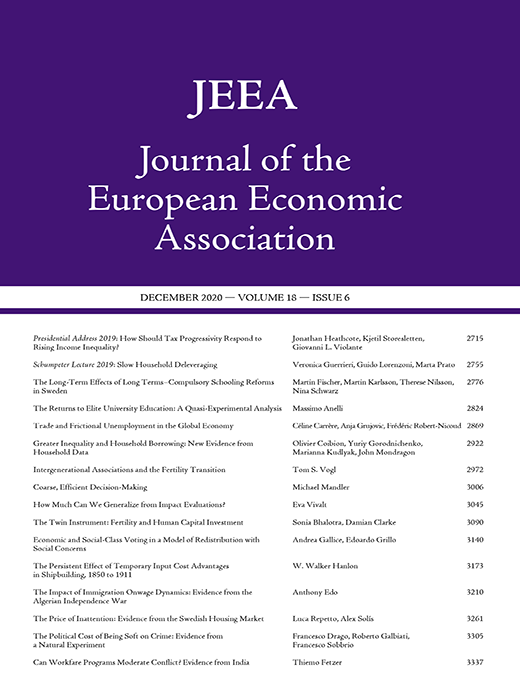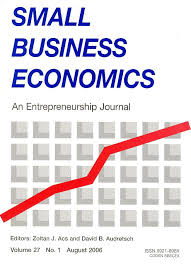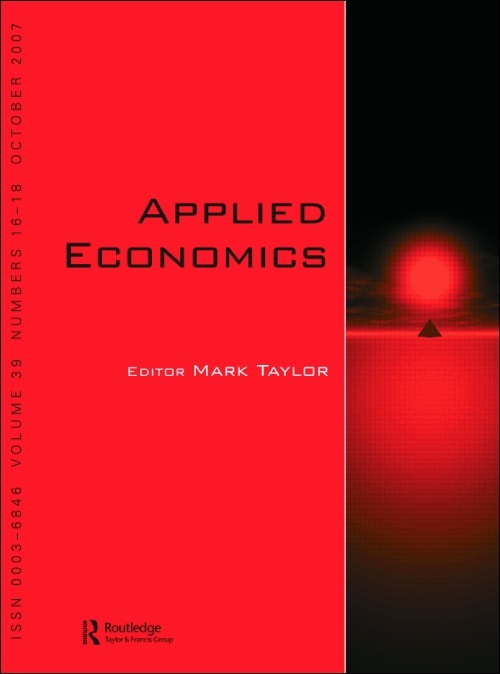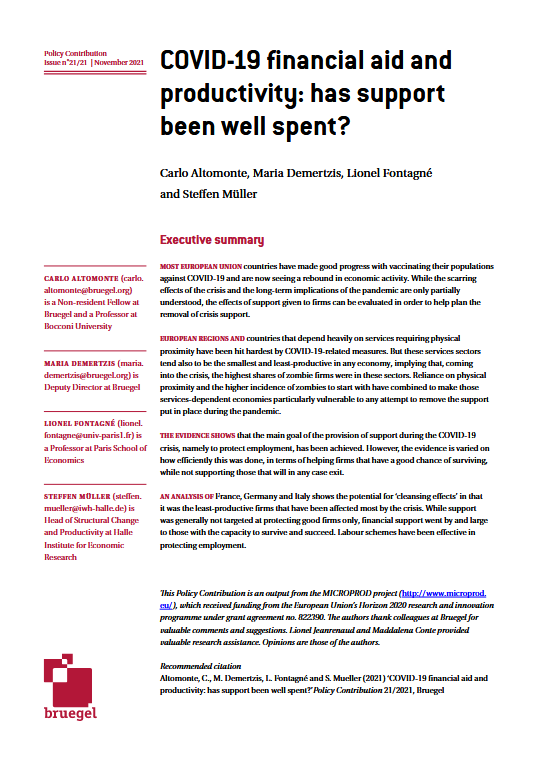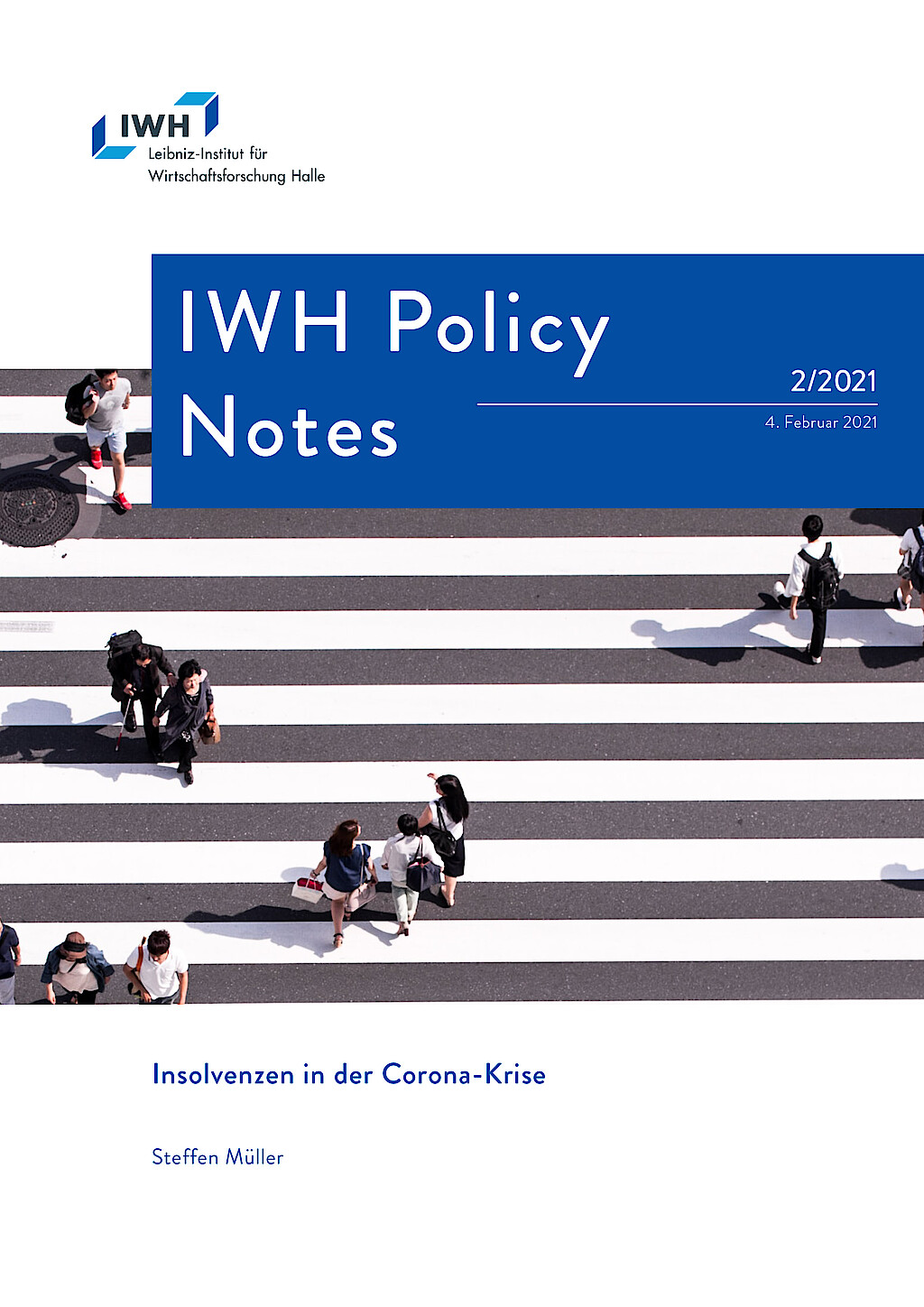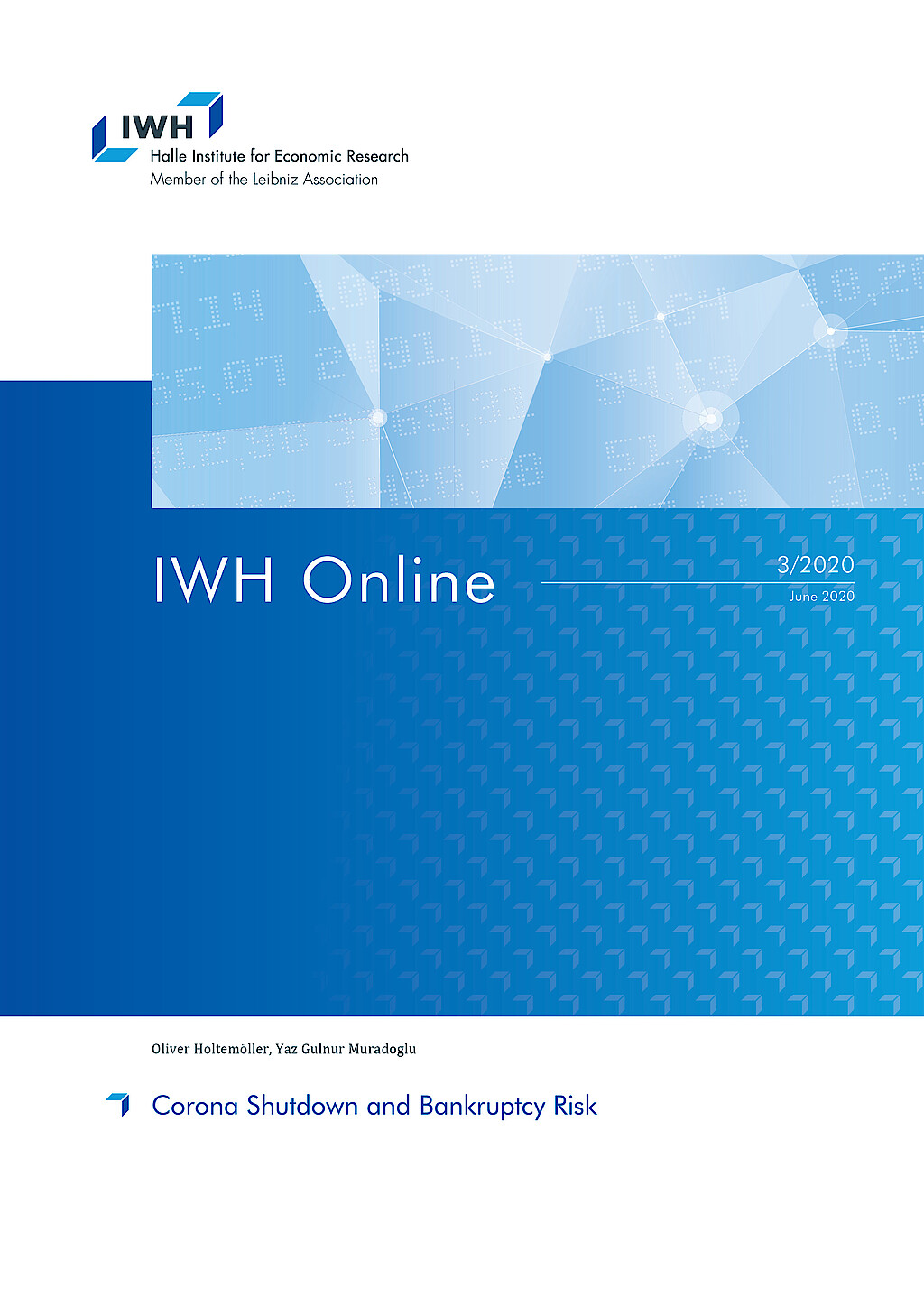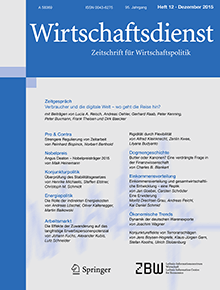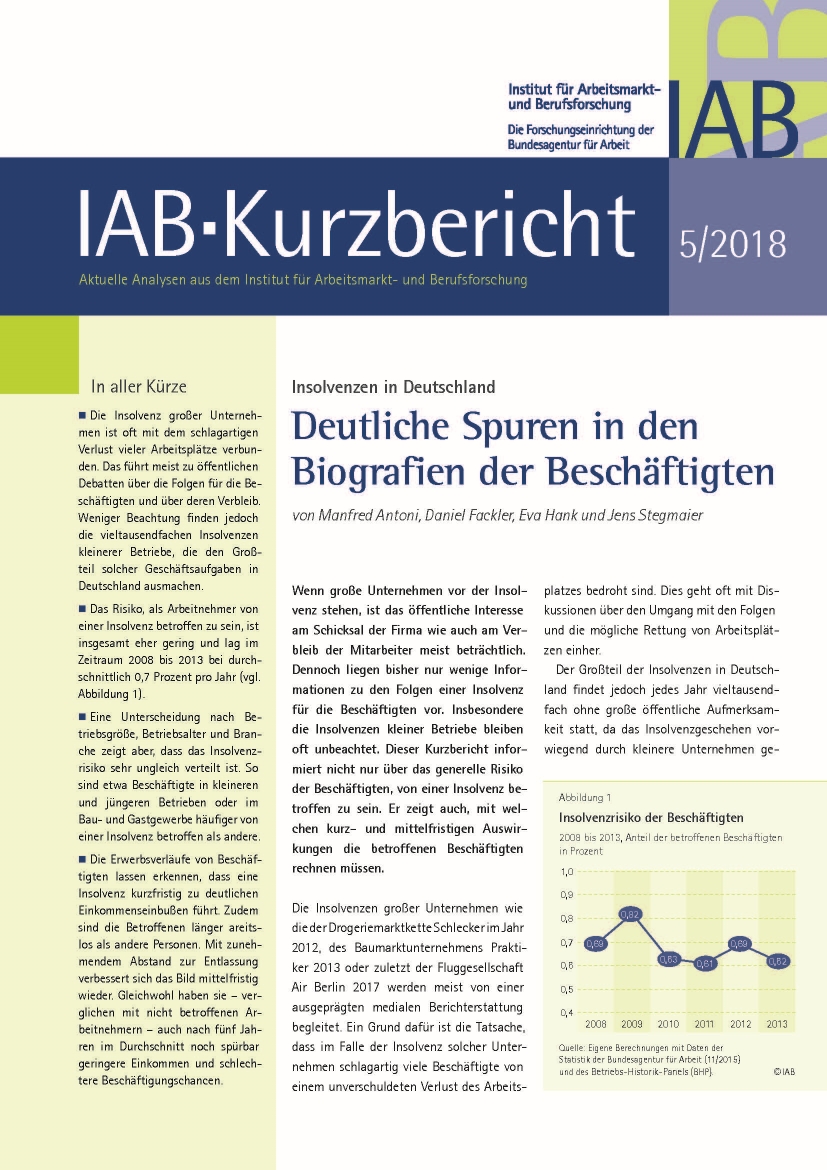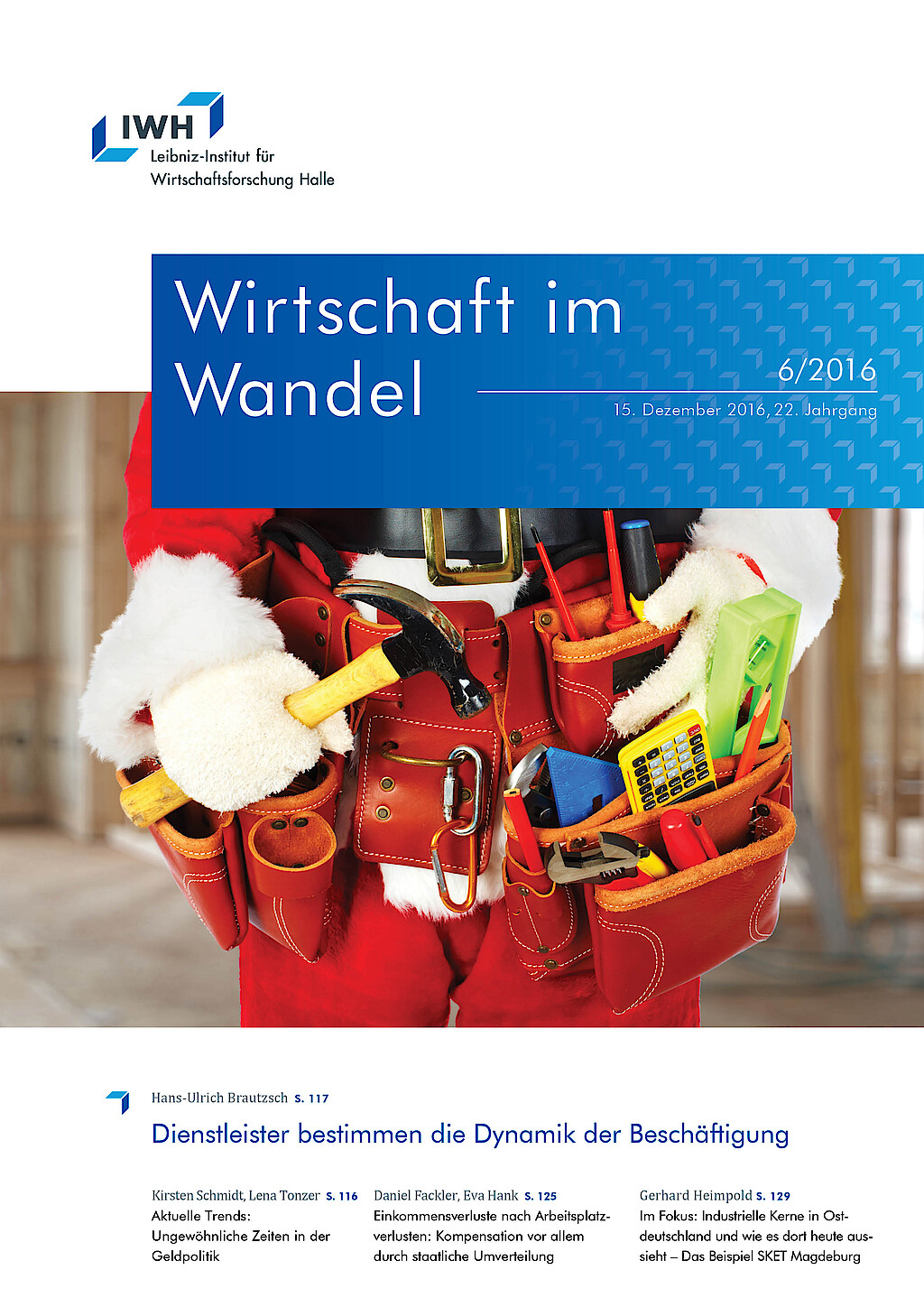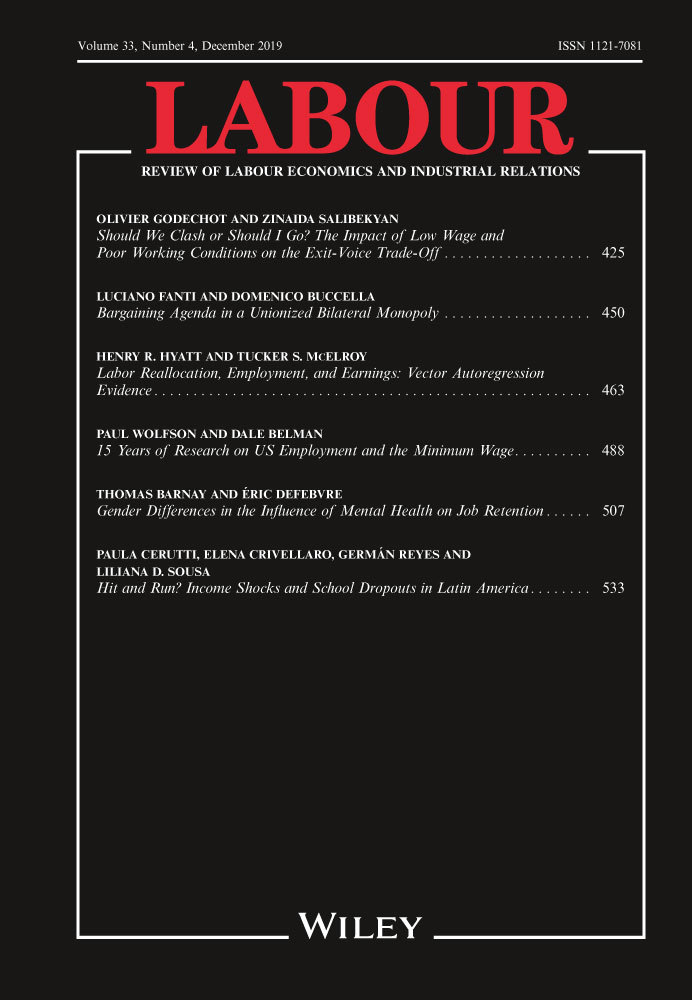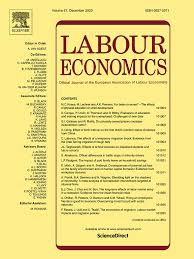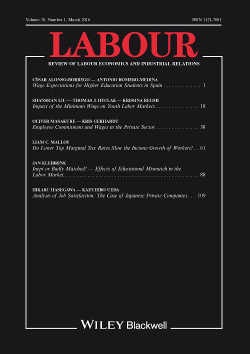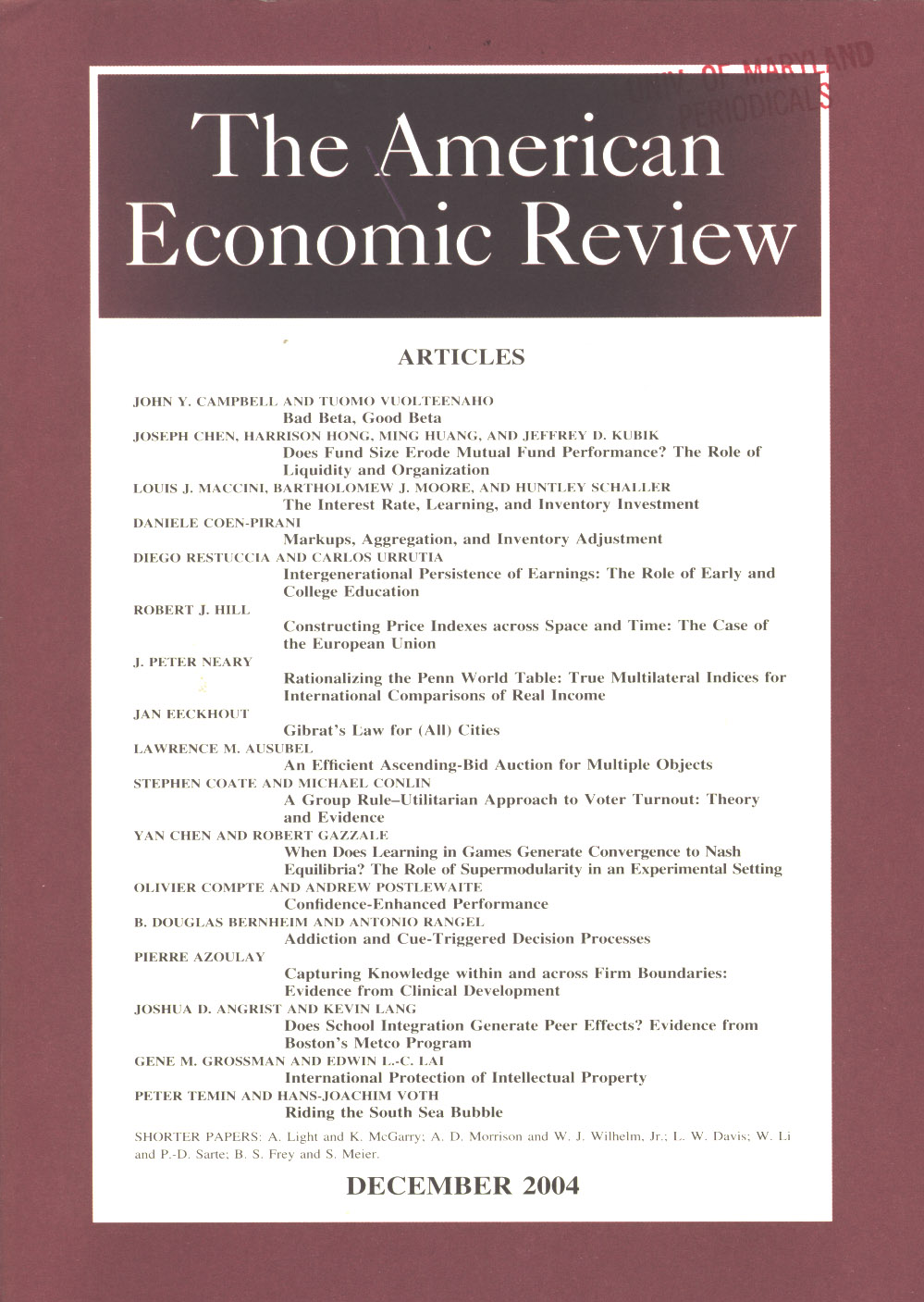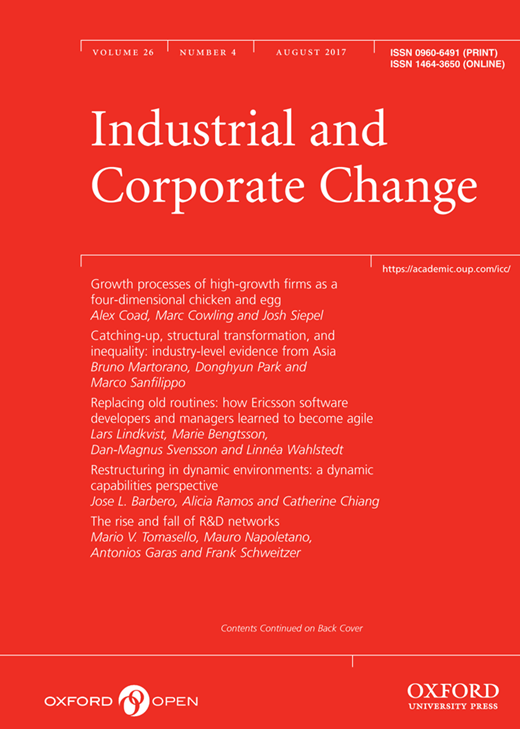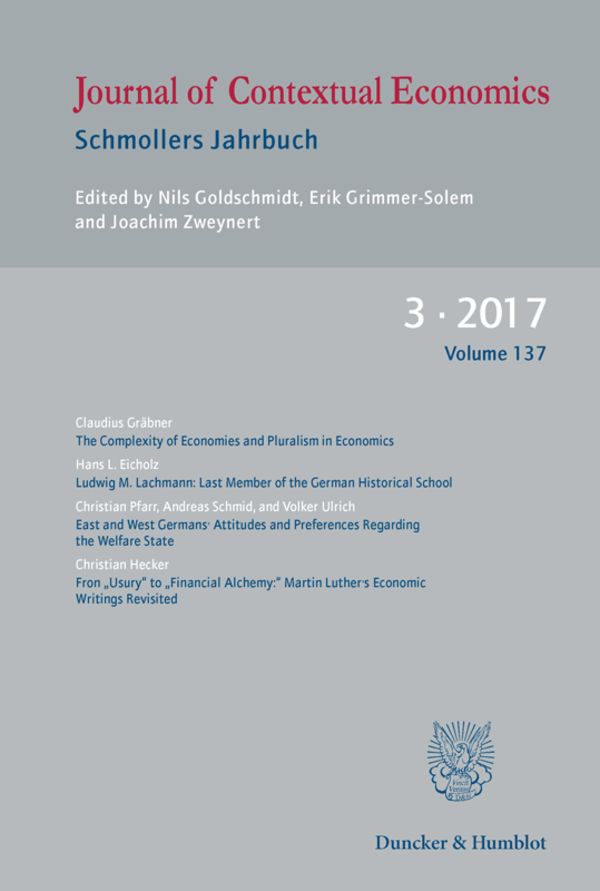08.04.2025 • 12/2025
IWH-Tarif-Check: Keine realen Netto-Tariflohnzuwächse für Beschäftigte im Öffentlichen Dienst
Abstract
Steigende Sozialabgaben und Inflation fressen Gehaltsplus der Beschäftigten bei Bund und Kommunen auf
The Bankruptcy Research Unit of the Halle Institute for Economic Research (IWH) presents the Institute’s research on the topics of corporate bankruptcy, firm exit, and the consequences for affected employees. It issues the IWH Bankruptcy Update on a monthly basis. The Update presents the most recent bankruptcy numbers much earlier than official statistics.
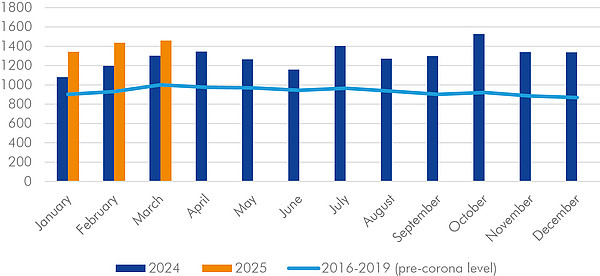

Steigende Sozialabgaben und Inflation fressen Gehaltsplus der Beschäftigten bei Bund und Kommunen auf
The IWH Bankruptcy Research Unit collects the bankruptcy announcements of German courts to generate the monthly IWH Bankruptcy Update. Excluding very small firms being not listed in the business register, the Update focusses on a group of legal forms of companies typically covering about 90% of all employees affected by employer bankruptcy. Official statistics draw a comprehensive picture of the situation with a two months delay. The Update is considerably faster and only marginally deviates from official numbers. The IWH Bankrupcty Update therefore is a reliable flash indicator for corporate bankruptcy in Germany. In January 2021, a case-by-case revision of all bankruptcy notifications of the year 2020 has been done. It led to minor ex post changes of the bankruptcy figures.
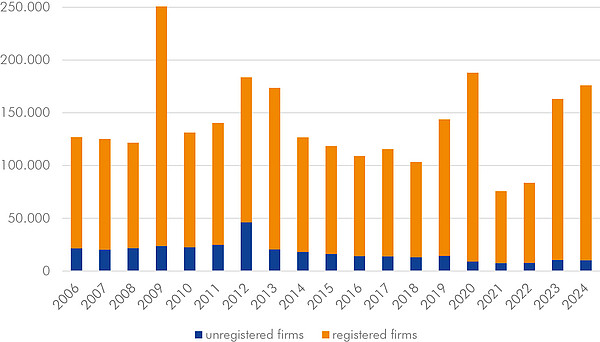
When a company files for bankruptcy, it takes on average two to three months for the courts to announce the start of bankruptcy proceedings. Only then does the bankruptcy appear in the IWH Bankruptcy Update and, with a further delay of two months, also in the official statistics. To provide the public with even more up to date figures, IWH researchers additionally draw on bankruptcy filing data to forecast official bankruptcy announcements for the coming two months.
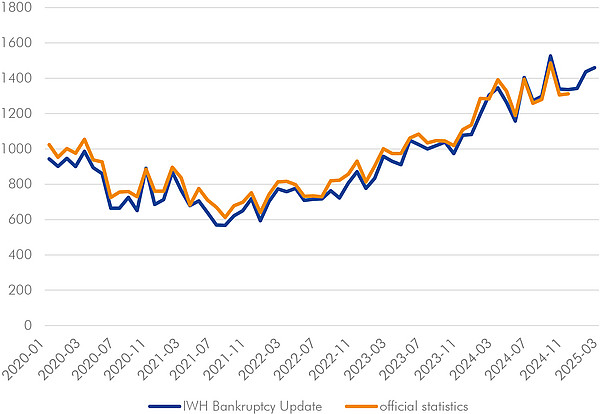
For some of our analyses , e.g. employment figures, we link the bankruptcy announcements of the courts with firm-level data provided by Bureau van Dijk (BvD), the latter comprising balance sheet and employment information. The BvD data is highly reliable for large firms whereas many small firms are not included. For this reason, our analyses using BvD data focus on large companies, only. Here we take account of the fact that consolidated balance sheets of parent companies may include subsidiaries that are not bankrupt. Employment reductions mostly occur within the last year before bankruptcy. Our balance sheet and employment information do not refer directly to the time of the bankruptcy announcement but mostly to previous years and thereby provide a more realistic picture of the economic effects of bankruptcies. To work with most up to date data, IWH merges its bankruptcy data with the most recent wave of BvD every six months. Typically, this leads to only minor changes in the reported employment numbers.
In January 2023, we switched from the AMADEUS database to the ORBIS database for the calculation of employee figures. In doing so, we also adjusted employee figures retroactively. The advantage of ORBIS is that companies stay in the data even if they become inactive or bankrupt. We can thus go farther back in time when linking bankruptcies with employee figures. This allows us to form consistent time series over longer periods, which is necessary for the new graphs of the IWH Bankruptcy Update.
If you have any further questions please contact me.
+49 345 7753-708 Request per E-Mail
Researcher, Institute for Employment Research (IAB), Nuremberg, and IWH Research Affiliate; research focus: evolution and failure of firms, consequences for affected employees, industrial relations, non-standard employment.

Chair of Civil Law, Civil Procedure and Insolvency Law at Martin Luther University Halle-Wittenberg; research focus: insolvency and restructuring law, comparative analysis of relevant regulatory approaches in jurisdictions worldwide as well as in the soft law of international organizations.
MLU Website
German Research Foundation (DFG)
The project analyzes the process and the consequences of firm failure. For the first time, evidence on the consequences of small firms’ bankruptcy on employees’ earnings and wages is provided. The project e.g. shows that employees of small firms are more likely to see their employer failing but, at the same time, face smaller earnings and wage losses than employees displaced from larger firms. Check the below research articles for further insights.
Workers displaced in the course of employer bankruptcy face severe long-run earnings and wage losses. These losses are generally bigger for larger employers.
in: Journal of the European Economic Association, No. 5, 2021
This paper investigates whether wage losses after job displacement are driven by lost firm wage premiums or worker productivity depreciations. We estimate losses in wages and firm wage premiums, the latter being measured as firm effects from a two-way fixed-effects wage decomposition. Using new German administrative data on displacements from small and large employers, we find that wage losses are to a large extent explained by losses in firm wage premiums and that premium losses are largely permanent. We show that losses strongly increase with pre-displacement employer size. This provides an explanation for large and persistent wage losses reported in previous displacement studies typically focusing on large employers, only.
Testing their business concepts, young firms much more often file for bankruptcy than mature firms. Small firms are also more often affected by bankruptcy but the number of employees predicts failure among mature firms, only.
in: Small Business Economics, No. 3, 2015
This paper introduces a large-scale administrative panel data set on corporate bankruptcy in Germany that allows for an econometric analysis of involuntary exits where previous studies mixed voluntary and involuntary exits. Approximately 83 % of all bankruptcies occur in plants with not more than 10 employees, and 61 % of all bankrupt plants are not older than 5 years. The descriptive statistics and regression analysis indicate substantial negative age dependence with respect to bankruptcy risk but confirm negative size dependence for mature plants only. Our results corroborate hypotheses stressing increasing capabilities and positional advantage, both predicting negative age dependence with respect to bankruptcy risk due to productivity improvements. The results are not consistent with the theories explaining age dependence via imprinting or structural inertia.
Firm closure without bankruptcy is visible in below average employment performance already several years before closure. In contrast, bankruptcy comes with a shorter warning period. Results indicate that many closures without bankruptcy are planned while bankruptcy is often preceded by a short struggle for survival.
in: Applied Economics, No. 50, 2018
This article analyzes the development of employment levels and worker flows before bankruptcies, plant closure without bankruptcies and mass layoffs. Utilizing administrative plant-level data for Germany, we find no systematic employment reductions prior to mass layoffs, a strong and long-lasting reduction prior to closures, and a much shorter shadow of death preceding bankruptcies. Employment reductions in closing plants, in contrast to bankruptcies and mass layoffs, do not come along with increased worker flows. These patterns point to an intended and controlled shrinking strategy for closures without bankruptcy and to an unintended collapse for bankruptcies and mass layoffs.
in: Bruegel-Policy Contributions, No. 21, 2021
Most European Union countries have made good progress with vaccinating their populations against COVID-19 and are now seeing a rebound in economic activity. While the scarring effects of the crisis and the long-term implications of the pandemic are only partially understood, the effects of support given to firms can be evaluated in order to help plan the removal of crisis support. An analysis of France, Germany and Italy shows the potential for ‘cleansing effects’ in that it was the least-productive firms that have been affected most by the crisis. While support was generally not targeted at protecting good firms only, financial support went by and large to those with the capacity to survive and succeed. Labour schemes have been effective in protecting employment.
in: IWH Policy Notes, No. 2, 2021
Die Insolvenzzahlen sind trotz Corona-Krise im Jahr 2020 stark gesunken. Diese paradoxe Situation kann in erster Linie durch staatliche Unterstützungsmaßnahmen und abwartendes Verhalten bei den Unternehmen erklärt werden. Die Krise traf die meisten Unternehmen am Ende einer langanhaltenden wirtschaftlichen Boomphase und somit haben viele Unternehmen umfangreiche Reserven aufgebaut, die sie in Erwartung eines Nach-Corona Booms aufbrauchen. Obwohl eine Insolvenzwelle ab Frühjahr nicht auszuschließen ist, ist sie doch eher unwahrscheinlich. Der Staat muss seine Kräfte bündeln um ein Wiederaufflammen der Pandemie nach dem Sommer 2021 zu verhindern und gleichzeitig die Stützungsmaßnahmen bereits im Jahr 2021 beenden, um eine „Zombifizierung“ der Wirtschaft zu unterbinden.
in: IWH Online, No. 3, 2020
This paper investigates the consequences of shutdowns during the Corona crisis on the risk of bankruptcy for firms in Germany and United Kingdom. We use financial statements from the period 2014 to 2018 to predict how pervasive risk of bankruptcy becomes for micro, small, medium, and large firms due to shutdown measures. We estimate distress for firms using their capacity to service their debt. Our results indicate that under three months of shutdown almost all firms in shutdown industries face high risk of bankruptcy. In Germany, about 99% of firms in shutdown industries and in the UK about 98% of firms in shutdown industries are predicted to be under distress. The furlough schemes reduce the risk of bankruptcy only marginally to 97% of firms in shutdown industries in Germany and 95% of firms in shutdown industries in the United Kingdom in case of a three-month shutdown. In sectors that are not shutdown under conservative estimates of contagion of sales losses, our results indicate considerable risk of widespread bankruptcies ranging from 76% of firms in Germany to 69% of firms in the United Kingdom. These early findings suggest that the impact of corona crisis on corporate sector via shutdowns can be severe and subsequent policy should be designed accordingly.
in: Wirtschaftsdienst, No. 6, 2019
Unternehmensinsolvenzen sind nicht nur für Eigentümer und Gläubiger mit erheblichen Unannehmlichkeiten verbunden, sie haben zumeist auch schwerwiegende Auswirkungen auf die Arbeitnehmer, die dadurch in aller Regel ihre Arbeitsplätze verlieren. Insbesondere Insolvenzen großer Unternehmen mit mehreren Tausend Beschäftigten – prominente Fälle sind beispielsweise Schlecker, Praktiker oder Air Berlin – führen gelegentlich dazu, dass die Schicksale der betroffenen Arbeitnehmer auch in den Fokus einer breiteren Öffentlichkeit geraten. Das Interesse von Politik und Medien lässt jedoch meist schnell wieder nach, obwohl Unternehmensinsolvenzen natürlich weitaus häufiger vorkommen. Zwar ist die Zahl der Unternehmensinsolvenzen seit einigen Jahren rückläufig, dennoch waren 2018 deutschlandweit fast 20 000 Unternehmen und 200 000 Arbeitsplätze betroffen.
in: Wirtschaft im Wandel, No. 4, 2018
Schließungen und Massenentlassungen großer Unternehmen stoßen aufgrund der damit verbundenen Folgen für betroffene Arbeitnehmerinnen und Arbeitnehmer meist auf breites öffentliches Interesse. Tatsächlich zeigt sich, dass die Verdienstausfälle betroffener Arbeitnehmer – bestehend aus Lohneinbußen bei späterer Wiederbeschäftigung und Beschäftigungsausfällen – deutlich mit der Größe des entlassenden Betriebs zunehmen. Dies liegt vor allem daran, dass aus Großbetrieben entlassene Arbeitnehmer im Gegensatz zu denen, die einen Arbeitsplatz in kleinen Betrieben verlieren, deutliche Lohneinbußen hinnehmen müssen, weil sie danach oft in kleineren und schlechter bezahlenden Betrieben beschäftigt sind. Zwar erleiden auch aus Kleinbetrieben entlassene Arbeitnehmer deutliche Verdienstausfälle, ihre Lohneinbußen sind aber geringer. Sie können sich bei der Entlohnung sogar verbessern, sofern sie das Glück haben, eine Anstellung in einem Großbetrieb zu finden.
in: IAB-Kurzbericht 05/2018, Nürnberg, 2018
Wenn große Unternehmen vor der Insolvenz stehen, ist das öffentliche Interesse am Schicksal der Firma wie auch am Verbleib der Mitarbeiter meist beträchtlich. Dennoch liegen bisher nur wenige Informationen zu den Folgen einer Insolvenz für die Beschäftigten vor. Insbesondere die Insolvenzen kleiner Betriebe bleiben oft unbeachtet. Dieser Kurzbericht informiert nicht nur über das generelle Risiko der Beschäftigten, von einer Insolvenz betroffen zu sein. Er zeigt auch, mit welchen kurz- und mittelfristigen Auswirkungen die betroffenen Beschäftigten rechnen müssen. Dabei werden insbesondere die Effekte einer Insolvenz auf die Erwerbseinkommen und auf die Beschäftigungschancen der Betroffenen untersucht.
in: Wirtschaft im Wandel, No. 6, 2016
Zahlreiche Studien zeigen, dass unfreiwillige Arbeitsplatzverluste zu hohen und langfristigen Einkommensverlusten bei betroffenen Arbeitnehmern führen. Die vorliegende Studie verwendet Befragungsdaten des Sozio-oekonomischen Panels (SOEP), um erstmals umfassend zu untersuchen, ob und in welchem Ausmaß Verluste im individuellen Arbeitseinkommen durch alternative Einkommensquellen, Reaktionen anderer Haushaltsmitglieder und durch staatliche Umverteilung ausgeglichen werden. Die Ergebnisse zeigen, dass Verdienstverluste vor allem durch staatliche Umverteilung kompensiert werden, wohingegen andere Kanäle nur eine untergeordnete Rolle spielen. Ein Vergleich internationaler empirischer Evidenz zu den Verdienstausfällen nach Arbeitsplatzverlusten spricht nicht dafür, dass staatliche Umverteilung den Anreiz, Verluste durch eigene Anstrengungen selbst auszugleichen, vermindert.
in: Wirtschaftsdienst, No. 2, 2015
Schließungen nicht wettbewerbsfähiger Betriebe sind ein wesentliches Element der Marktwirtschaft, werden aber oft kontrovers diskutiert. Wie hoch ist das Risiko einer Betriebsschließung überhaupt und wie hat es sich im Lauf der Zeit entwickelt? Welche Betriebe sind besonders gefährdet? Sterben Betriebe eher einen plötzlichen Tod oder zeichnen sich Betriebsschließungen oft schon Jahre im Voraus ab?
in: Journal of the European Economic Association, No. 5, 2021
This paper investigates whether wage losses after job displacement are driven by lost firm wage premiums or worker productivity depreciations. We estimate losses in wages and firm wage premiums, the latter being measured as firm effects from a two-way fixed-effects wage decomposition. Using new German administrative data on displacements from small and large employers, we find that wage losses are to a large extent explained by losses in firm wage premiums and that premium losses are largely permanent. We show that losses strongly increase with pre-displacement employer size. This provides an explanation for large and persistent wage losses reported in previous displacement studies typically focusing on large employers, only.
in: LABOUR: Review of Labour Economics and Industrial Relations, No. 3, 2020
Using survey data from the German Socio‐Economic Panel (SOEP), this paper analyses the extent to which alternative income sources, reactions within the household context, and redistribution by the state attenuate earnings losses after job displacement. Applying propensity score matching and fixed effects estimations, we find that income from self‐employment reduces the earnings gap only slightly and severance payments buffer losses in the short run. On the household level, we find little evidence for an added worker effect whereas redistribution by the state within the tax and transfer system mitigates income losses substantially.
in: Labour Economics, 2019
We study the effect of job displacement due to bankruptcies on earnings and employment prospects of displaced workers and analyse whether extended potential unemployment benefit duration (PBD) ameliorates the negative consequences of job loss. Using German administrative linked employer-employee data, we find that job loss has long-lasting negative effects on earnings and employment. Displaced workers also more often end up in irregular employment relationships (part-time, marginal part-time employment, and temporary agency work) than their non-displaced counterparts. Applying a regression discontinuity approach that exploits a three months PBD extension at the age threshold of 50 we find hardly any effects of longer PBD on labour market outcomes of displaced workers.
in: Applied Economics, No. 50, 2018
This article analyzes the development of employment levels and worker flows before bankruptcies, plant closure without bankruptcies and mass layoffs. Utilizing administrative plant-level data for Germany, we find no systematic employment reductions prior to mass layoffs, a strong and long-lasting reduction prior to closures, and a much shorter shadow of death preceding bankruptcies. Employment reductions in closing plants, in contrast to bankruptcies and mass layoffs, do not come along with increased worker flows. These patterns point to an intended and controlled shrinking strategy for closures without bankruptcy and to an unintended collapse for bankruptcies and mass layoffs.
in: LABOUR: Review of Labour Economics and Industrial Relations, No. 4, 2017
Using German survey data, we investigate the relationship between involuntary job loss and regional mobility. Our results show that job loss has a strong positive effect on the propensity to relocate. We also analyse whether displaced workers who relocate to a different region after job loss are better able to catch up with non-displaced workers in terms of labour market performance than those staying in the same region. Our findings do not support this conjecture as we find substantial long-lasting earnings losses for movers and stayers and even slightly but not significantly higher losses for movers.
in: American Economic Review: Papers and Proceedings, No. 5, 2017
We use rich German administrative data to estimate new measures of skill transferability between manufacturing and other sectors. These measures capture the value of workers' human capital when applied in different sectors and are directly related to workers' displacement costs. We estimate these transferability measures using a selection correction model, which addresses workers' endogenous mobility, and a novel selection instrument based on the social network of workers. Our results indicate substantial heterogeneity in how workers can transfer their skills when they move across sectors, which implies heterogeneous displacement costs that depend on the sector to which workers reallocate.
in: Small Business Economics, No. 1, 2016
Using a 50 % sample of all private sector establishments in Germany, we report that spinoffs are larger, initially employ more skilled and more experienced workers, and pay higher wages than other startups. We investigate whether spinoffs are more likely to survive than other startups, and whether spinoff survival depends on the quality and size of their parent companies, as suggested in some of the theoretical and empirical literature. Our estimated survival models confirm that spinoffs are generally less likely to exit than other startups. We also distinguish between pulled spinoffs, where the parent company continues after they are founded, and pushed spinoffs, where the parent company stops operations. Our results indicate that in western and eastern Germany and in all sectors investigated, pulled spinoffs have a higher probability of survival than pushed spinoffs. Concerning the parent connection, we find that intra-industry spinoffs and spinoffs emerging from better-performing or smaller parent companies are generally less likely to exit.
in: Small Business Economics, No. 3, 2015
This paper introduces a large-scale administrative panel data set on corporate bankruptcy in Germany that allows for an econometric analysis of involuntary exits where previous studies mixed voluntary and involuntary exits. Approximately 83 % of all bankruptcies occur in plants with not more than 10 employees, and 61 % of all bankrupt plants are not older than 5 years. The descriptive statistics and regression analysis indicate substantial negative age dependence with respect to bankruptcy risk but confirm negative size dependence for mature plants only. Our results corroborate hypotheses stressing increasing capabilities and positional advantage, both predicting negative age dependence with respect to bankruptcy risk due to productivity improvements. The results are not consistent with the theories explaining age dependence via imprinting or structural inertia.
in: Industrial and Corporate Change, No. 4, 2014
Using a large administrative data set for Germany, this article compares employment developments in exiting and surviving establishments. Applying a matching approach, we find a clear “shadow of death” effect reflecting lingering illness: in both West and East Germany establishments shrink dramatically already several years before closure, employment growth rates differ strongly between exiting and surviving establishments, and this difference becomes stronger as exit approaches. Moreover, we provide first evidence that prior to exit the workforce becomes on average more skilled, more female, and older in exiting compared to surviving establishments. These effects are more clearly visible in West than in East Germany.
in: Schmollers Jahrbuch, No. 2, 2014
Anhand umfangreicher administrativer Daten vergleicht diese Studie die Entwicklung der Überlebenschancen neu gegründeter Betriebe in West- und Ostdeutschland für die Jahre 1994 bis 2008. Eine zentrale Frage lautet dabei, ob eine Angleichung der Überlebensraten zwischen West- und Ostdeutschland zu beobachten ist. Anhand von Methoden der Verweildaueranalyse kommt die Studie zu dem Ergebnis, dass sich die Überlebenschancen neu gegründeter Betriebe zu Beginn des Beobachtungszeitraums nicht stark zwischen West- und Ostdeutschland unterscheiden. In den Jahren 1998 und 1999 steigt die Schließungswahrscheinlichkeit in Ostdeutschland stark an, in Westdeutschland jedoch nicht, was vermutlich auf eine Änderung der Subventionspolitik für Betriebe in Ostdeutschland zurückzuführen ist. Seit der Jahrtausendwende nimmt der Unterschied in den Schließungswahrscheinlichkeiten zwischen West- und Ostdeutschland ab, was auf eine Angleichung der Überlebenschancen hindeutet.
in: Small Business Economics, No. 3, 2013
Using comprehensive data for West Germany, this paper investigates the determinants of establishment exit. We find that between 1975 and 2006 the average exit rate has risen considerably. In order to test various “liabilities” of establishment survival identified in the literature, we analyzed the impact of establishment size and put a special focus on differences between young and mature establishments. Our empirical analysis shows that the mortality risk falls with establishment size, which confirms the liability of smallness. The probability of exit is substantially higher for young establishments which are not more than 5 years old, thus confirming the liability of newness. There also exists a liability of aging since exit rates first decline over time, reaching a minimum at ages 15–18, and then rise again somewhat. The determinants of exit differ substantially between young and mature establishments, suggesting that young establishments are more vulnerable in a number of ways.
in: Bruegel-Policy Contributions, No. 21, 2021
Most European Union countries have made good progress with vaccinating their populations against COVID-19 and are now seeing a rebound in economic activity. While the scarring effects of the crisis and the long-term implications of the pandemic are only partially understood, the effects of support given to firms can be evaluated in order to help plan the removal of crisis support. An analysis of France, Germany and Italy shows the potential for ‘cleansing effects’ in that it was the least-productive firms that have been affected most by the crisis. While support was generally not targeted at protecting good firms only, financial support went by and large to those with the capacity to survive and succeed. Labour schemes have been effective in protecting employment.
in: IWH Policy Notes, No. 2, 2021
Die Insolvenzzahlen sind trotz Corona-Krise im Jahr 2020 stark gesunken. Diese paradoxe Situation kann in erster Linie durch staatliche Unterstützungsmaßnahmen und abwartendes Verhalten bei den Unternehmen erklärt werden. Die Krise traf die meisten Unternehmen am Ende einer langanhaltenden wirtschaftlichen Boomphase und somit haben viele Unternehmen umfangreiche Reserven aufgebaut, die sie in Erwartung eines Nach-Corona Booms aufbrauchen. Obwohl eine Insolvenzwelle ab Frühjahr nicht auszuschließen ist, ist sie doch eher unwahrscheinlich. Der Staat muss seine Kräfte bündeln um ein Wiederaufflammen der Pandemie nach dem Sommer 2021 zu verhindern und gleichzeitig die Stützungsmaßnahmen bereits im Jahr 2021 beenden, um eine „Zombifizierung“ der Wirtschaft zu unterbinden.
in: IWH Online, No. 3, 2020
This paper investigates the consequences of shutdowns during the Corona crisis on the risk of bankruptcy for firms in Germany and United Kingdom. We use financial statements from the period 2014 to 2018 to predict how pervasive risk of bankruptcy becomes for micro, small, medium, and large firms due to shutdown measures. We estimate distress for firms using their capacity to service their debt. Our results indicate that under three months of shutdown almost all firms in shutdown industries face high risk of bankruptcy. In Germany, about 99% of firms in shutdown industries and in the UK about 98% of firms in shutdown industries are predicted to be under distress. The furlough schemes reduce the risk of bankruptcy only marginally to 97% of firms in shutdown industries in Germany and 95% of firms in shutdown industries in the United Kingdom in case of a three-month shutdown. In sectors that are not shutdown under conservative estimates of contagion of sales losses, our results indicate considerable risk of widespread bankruptcies ranging from 76% of firms in Germany to 69% of firms in the United Kingdom. These early findings suggest that the impact of corona crisis on corporate sector via shutdowns can be severe and subsequent policy should be designed accordingly.
in: Wirtschaftsdienst, No. 6, 2019
Unternehmensinsolvenzen sind nicht nur für Eigentümer und Gläubiger mit erheblichen Unannehmlichkeiten verbunden, sie haben zumeist auch schwerwiegende Auswirkungen auf die Arbeitnehmer, die dadurch in aller Regel ihre Arbeitsplätze verlieren. Insbesondere Insolvenzen großer Unternehmen mit mehreren Tausend Beschäftigten – prominente Fälle sind beispielsweise Schlecker, Praktiker oder Air Berlin – führen gelegentlich dazu, dass die Schicksale der betroffenen Arbeitnehmer auch in den Fokus einer breiteren Öffentlichkeit geraten. Das Interesse von Politik und Medien lässt jedoch meist schnell wieder nach, obwohl Unternehmensinsolvenzen natürlich weitaus häufiger vorkommen. Zwar ist die Zahl der Unternehmensinsolvenzen seit einigen Jahren rückläufig, dennoch waren 2018 deutschlandweit fast 20 000 Unternehmen und 200 000 Arbeitsplätze betroffen.
in: Wirtschaft im Wandel, No. 4, 2018
Schließungen und Massenentlassungen großer Unternehmen stoßen aufgrund der damit verbundenen Folgen für betroffene Arbeitnehmerinnen und Arbeitnehmer meist auf breites öffentliches Interesse. Tatsächlich zeigt sich, dass die Verdienstausfälle betroffener Arbeitnehmer – bestehend aus Lohneinbußen bei späterer Wiederbeschäftigung und Beschäftigungsausfällen – deutlich mit der Größe des entlassenden Betriebs zunehmen. Dies liegt vor allem daran, dass aus Großbetrieben entlassene Arbeitnehmer im Gegensatz zu denen, die einen Arbeitsplatz in kleinen Betrieben verlieren, deutliche Lohneinbußen hinnehmen müssen, weil sie danach oft in kleineren und schlechter bezahlenden Betrieben beschäftigt sind. Zwar erleiden auch aus Kleinbetrieben entlassene Arbeitnehmer deutliche Verdienstausfälle, ihre Lohneinbußen sind aber geringer. Sie können sich bei der Entlohnung sogar verbessern, sofern sie das Glück haben, eine Anstellung in einem Großbetrieb zu finden.
in: IAB-Kurzbericht 05/2018, Nürnberg, 2018
Wenn große Unternehmen vor der Insolvenz stehen, ist das öffentliche Interesse am Schicksal der Firma wie auch am Verbleib der Mitarbeiter meist beträchtlich. Dennoch liegen bisher nur wenige Informationen zu den Folgen einer Insolvenz für die Beschäftigten vor. Insbesondere die Insolvenzen kleiner Betriebe bleiben oft unbeachtet. Dieser Kurzbericht informiert nicht nur über das generelle Risiko der Beschäftigten, von einer Insolvenz betroffen zu sein. Er zeigt auch, mit welchen kurz- und mittelfristigen Auswirkungen die betroffenen Beschäftigten rechnen müssen. Dabei werden insbesondere die Effekte einer Insolvenz auf die Erwerbseinkommen und auf die Beschäftigungschancen der Betroffenen untersucht.
in: Wirtschaft im Wandel, No. 6, 2016
Zahlreiche Studien zeigen, dass unfreiwillige Arbeitsplatzverluste zu hohen und langfristigen Einkommensverlusten bei betroffenen Arbeitnehmern führen. Die vorliegende Studie verwendet Befragungsdaten des Sozio-oekonomischen Panels (SOEP), um erstmals umfassend zu untersuchen, ob und in welchem Ausmaß Verluste im individuellen Arbeitseinkommen durch alternative Einkommensquellen, Reaktionen anderer Haushaltsmitglieder und durch staatliche Umverteilung ausgeglichen werden. Die Ergebnisse zeigen, dass Verdienstverluste vor allem durch staatliche Umverteilung kompensiert werden, wohingegen andere Kanäle nur eine untergeordnete Rolle spielen. Ein Vergleich internationaler empirischer Evidenz zu den Verdienstausfällen nach Arbeitsplatzverlusten spricht nicht dafür, dass staatliche Umverteilung den Anreiz, Verluste durch eigene Anstrengungen selbst auszugleichen, vermindert.
in: Wirtschaftsdienst, No. 2, 2015
Schließungen nicht wettbewerbsfähiger Betriebe sind ein wesentliches Element der Marktwirtschaft, werden aber oft kontrovers diskutiert. Wie hoch ist das Risiko einer Betriebsschließung überhaupt und wie hat es sich im Lauf der Zeit entwickelt? Welche Betriebe sind besonders gefährdet? Sterben Betriebe eher einen plötzlichen Tod oder zeichnen sich Betriebsschließungen oft schon Jahre im Voraus ab?
in: Journal of the European Economic Association, No. 5, 2021
This paper investigates whether wage losses after job displacement are driven by lost firm wage premiums or worker productivity depreciations. We estimate losses in wages and firm wage premiums, the latter being measured as firm effects from a two-way fixed-effects wage decomposition. Using new German administrative data on displacements from small and large employers, we find that wage losses are to a large extent explained by losses in firm wage premiums and that premium losses are largely permanent. We show that losses strongly increase with pre-displacement employer size. This provides an explanation for large and persistent wage losses reported in previous displacement studies typically focusing on large employers, only.
in: LABOUR: Review of Labour Economics and Industrial Relations, No. 3, 2020
Using survey data from the German Socio‐Economic Panel (SOEP), this paper analyses the extent to which alternative income sources, reactions within the household context, and redistribution by the state attenuate earnings losses after job displacement. Applying propensity score matching and fixed effects estimations, we find that income from self‐employment reduces the earnings gap only slightly and severance payments buffer losses in the short run. On the household level, we find little evidence for an added worker effect whereas redistribution by the state within the tax and transfer system mitigates income losses substantially.
in: Labour Economics, 2019
We study the effect of job displacement due to bankruptcies on earnings and employment prospects of displaced workers and analyse whether extended potential unemployment benefit duration (PBD) ameliorates the negative consequences of job loss. Using German administrative linked employer-employee data, we find that job loss has long-lasting negative effects on earnings and employment. Displaced workers also more often end up in irregular employment relationships (part-time, marginal part-time employment, and temporary agency work) than their non-displaced counterparts. Applying a regression discontinuity approach that exploits a three months PBD extension at the age threshold of 50 we find hardly any effects of longer PBD on labour market outcomes of displaced workers.
in: Applied Economics, No. 50, 2018
This article analyzes the development of employment levels and worker flows before bankruptcies, plant closure without bankruptcies and mass layoffs. Utilizing administrative plant-level data for Germany, we find no systematic employment reductions prior to mass layoffs, a strong and long-lasting reduction prior to closures, and a much shorter shadow of death preceding bankruptcies. Employment reductions in closing plants, in contrast to bankruptcies and mass layoffs, do not come along with increased worker flows. These patterns point to an intended and controlled shrinking strategy for closures without bankruptcy and to an unintended collapse for bankruptcies and mass layoffs.
in: LABOUR: Review of Labour Economics and Industrial Relations, No. 4, 2017
Using German survey data, we investigate the relationship between involuntary job loss and regional mobility. Our results show that job loss has a strong positive effect on the propensity to relocate. We also analyse whether displaced workers who relocate to a different region after job loss are better able to catch up with non-displaced workers in terms of labour market performance than those staying in the same region. Our findings do not support this conjecture as we find substantial long-lasting earnings losses for movers and stayers and even slightly but not significantly higher losses for movers.
in: American Economic Review: Papers and Proceedings, No. 5, 2017
We use rich German administrative data to estimate new measures of skill transferability between manufacturing and other sectors. These measures capture the value of workers' human capital when applied in different sectors and are directly related to workers' displacement costs. We estimate these transferability measures using a selection correction model, which addresses workers' endogenous mobility, and a novel selection instrument based on the social network of workers. Our results indicate substantial heterogeneity in how workers can transfer their skills when they move across sectors, which implies heterogeneous displacement costs that depend on the sector to which workers reallocate.
in: Small Business Economics, No. 1, 2016
Using a 50 % sample of all private sector establishments in Germany, we report that spinoffs are larger, initially employ more skilled and more experienced workers, and pay higher wages than other startups. We investigate whether spinoffs are more likely to survive than other startups, and whether spinoff survival depends on the quality and size of their parent companies, as suggested in some of the theoretical and empirical literature. Our estimated survival models confirm that spinoffs are generally less likely to exit than other startups. We also distinguish between pulled spinoffs, where the parent company continues after they are founded, and pushed spinoffs, where the parent company stops operations. Our results indicate that in western and eastern Germany and in all sectors investigated, pulled spinoffs have a higher probability of survival than pushed spinoffs. Concerning the parent connection, we find that intra-industry spinoffs and spinoffs emerging from better-performing or smaller parent companies are generally less likely to exit.
in: Small Business Economics, No. 3, 2015
This paper introduces a large-scale administrative panel data set on corporate bankruptcy in Germany that allows for an econometric analysis of involuntary exits where previous studies mixed voluntary and involuntary exits. Approximately 83 % of all bankruptcies occur in plants with not more than 10 employees, and 61 % of all bankrupt plants are not older than 5 years. The descriptive statistics and regression analysis indicate substantial negative age dependence with respect to bankruptcy risk but confirm negative size dependence for mature plants only. Our results corroborate hypotheses stressing increasing capabilities and positional advantage, both predicting negative age dependence with respect to bankruptcy risk due to productivity improvements. The results are not consistent with the theories explaining age dependence via imprinting or structural inertia.
in: Industrial and Corporate Change, No. 4, 2014
Using a large administrative data set for Germany, this article compares employment developments in exiting and surviving establishments. Applying a matching approach, we find a clear “shadow of death” effect reflecting lingering illness: in both West and East Germany establishments shrink dramatically already several years before closure, employment growth rates differ strongly between exiting and surviving establishments, and this difference becomes stronger as exit approaches. Moreover, we provide first evidence that prior to exit the workforce becomes on average more skilled, more female, and older in exiting compared to surviving establishments. These effects are more clearly visible in West than in East Germany.
in: Schmollers Jahrbuch, No. 2, 2014
Anhand umfangreicher administrativer Daten vergleicht diese Studie die Entwicklung der Überlebenschancen neu gegründeter Betriebe in West- und Ostdeutschland für die Jahre 1994 bis 2008. Eine zentrale Frage lautet dabei, ob eine Angleichung der Überlebensraten zwischen West- und Ostdeutschland zu beobachten ist. Anhand von Methoden der Verweildaueranalyse kommt die Studie zu dem Ergebnis, dass sich die Überlebenschancen neu gegründeter Betriebe zu Beginn des Beobachtungszeitraums nicht stark zwischen West- und Ostdeutschland unterscheiden. In den Jahren 1998 und 1999 steigt die Schließungswahrscheinlichkeit in Ostdeutschland stark an, in Westdeutschland jedoch nicht, was vermutlich auf eine Änderung der Subventionspolitik für Betriebe in Ostdeutschland zurückzuführen ist. Seit der Jahrtausendwende nimmt der Unterschied in den Schließungswahrscheinlichkeiten zwischen West- und Ostdeutschland ab, was auf eine Angleichung der Überlebenschancen hindeutet.
in: Small Business Economics, No. 3, 2013
Using comprehensive data for West Germany, this paper investigates the determinants of establishment exit. We find that between 1975 and 2006 the average exit rate has risen considerably. In order to test various “liabilities” of establishment survival identified in the literature, we analyzed the impact of establishment size and put a special focus on differences between young and mature establishments. Our empirical analysis shows that the mortality risk falls with establishment size, which confirms the liability of smallness. The probability of exit is substantially higher for young establishments which are not more than 5 years old, thus confirming the liability of newness. There also exists a liability of aging since exit rates first decline over time, reaching a minimum at ages 15–18, and then rise again somewhat. The determinants of exit differ substantially between young and mature establishments, suggesting that young establishments are more vulnerable in a number of ways.

